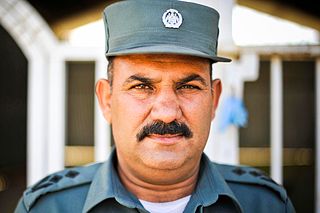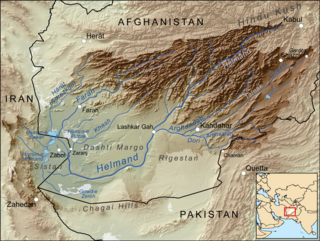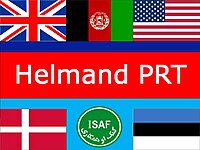
The International Security Assistance Force (ISAF) was a multinational military mission in Afghanistan from 2001 to 2014. It was established by United Nations Security Council Resolution 1386 pursuant to the Bonn Agreement, which outlined the establishment of a permanent Afghan government following the U.S. invasion in October 2001. ISAF's primary goal was to train the Afghan National Security Forces (ANSF) and assist Afghanistan in rebuilding key government institutions; however, it gradually took part in the broader war in Afghanistan against the Taliban insurgency.

A Provincial Reconstruction Team (PRT) was a unit introduced by the United States government, consisting of military officers, diplomats, and reconstruction subject matter experts, working to support reconstruction efforts in unstable states. PRTs were first established in Afghanistan in early 2002, and were used in Iraq as well. While the concepts are similar, PRTs in Afghanistan and Iraq had separate compositions and missions. Their common purpose, however, was to empower local governments to govern their constituents more effectively.

Helmand, also known as Hillmand, in ancient times, as Hermand and Hethumand, is one of the 34 provinces of Afghanistan, in the south of the country. It is the largest province by area, covering 58,584 square kilometres (20,000 sq mi) area. The province contains 13 districts, encompassing over 1,000 villages, and roughly 1,446,230 settled people. Lashkargah serves as the provincial capital.

Uruzgan, also spelled as Urozgan or Oruzgan, is one of the thirty-four provinces of Afghanistan. Uruzgan is located in the center of the country. The population is 436,079, and the province is mostly a tribal society. Tarinkot serves as the capital of the province.

The Counter Narcotics Police of Afghanistan (CNPA) was a specialist force under the Afghan Ministry of Interior Affairs created in 2003. The CNPA was the lead agency for counter narcotics investigations in Afghanistan and had an establishment of some 3000 officers. Candidates for the 5-week long Counter Narcotics Course must have completed an 8-week basic police course and are carefully selected.

Lashkargāh, historically called Bost or Boost, is a city in southwestern Afghanistan and the capital of Helmand Province. It is located in Lashkargah District, where the Arghandab River merges into the Helmand River. The city has a population of 201,546 as of 2006. Lashkargah is linked by major roads with Kandahar to the east, Zaranj on the border with Iran to the west, and Farah and Herat to the north-west. It is mostly very arid and desolate. However, farming does exist around the Helmand and Arghandab rivers. Bost Airport is located on the east bank of the Helmand River, five miles north of the junction of the Helmand and Arghandab rivers.
Combined Joint Task Force – 76 (CJTF-76) was a US led subordinate formation of Combined Forces Command – Afghanistan (CFC-A) headquartered in Kabul, Afghanistan. It was active from the time CFC-A stood up to the time the International Security Assistance Force (ISAF) took full command of the coalition military operations in Afghanistan in October 2006. CFC-A reported in its turn to United States Central Command. While CFC-Afghanistan was supposed to have inactivated sometime after November 30, 2006, CJTF-76 remained as a headquarters for ISAF's Regional Command East. CJTF-76 was replaced by Combined Joint Task Force 82, led by the 82nd Airborne Division, in the middle of 2007.

Operation Herrick was the codename under which all British operations in the War in Afghanistan were conducted from 2002 to the end of combat operations in 2014. It consisted of the British contribution to the NATO-led International Security Assistance Force (ISAF), and support to the American-led Operation Enduring Freedom (OEF), within the central Asian country.

Nāwa-I-Barakzāyi District is an administrative district in Helmand Province, Afghanistan located south of the provincial capital of Lashkar Gah along the Helmand River. It is bordered by the districts of Lashkar Gah, Nad Ali, Garmsir, and Rig, as well as the provinces of Nimruz and Kandahar. It falls within the area known as Pashtunistan,, an area comprising most of southeast Afghanistan and northwest Pakistan. The dominant language is Pashto and many of the 89,000 residents practice the traditional code of Pashtunwali. Nawa-I-Barakzayi's name reflects the dominant Pashtun tribe in the district, the Barakzai. Prior to the 1970s, it was called Shamalan after a small village at the south end of the district

The Helmand province campaign was a series of military operations conducted by the International Security Assistance Force (ISAF) forces against Taliban insurgents and other local groups in the Helmand Province of Afghanistan. Their objective was to control a province that was known to be a Taliban stronghold, and a center of opium production. None of the ISAF's intended strategic and political objectives were achieved in the long term.

The Battle of Musa Qala was a British-led military action in Helmand Province, southern Afghanistan, launched by the Afghan National Army and the International Security Assistance Force (ISAF) against the Taliban on 7 December 2007. After three days of intense fighting, the Taliban retreated into the mountains on 10 December. Musa Qala was officially reported captured on 12 December, with Afghan Army troops pushing into the town centre.

US and NATO International Security Assistance Force (ISAF) operations, alongside Afghan National Army forces, continued against the Taliban through 2007.

Operation Sond Chara was a campaign in the War in Afghanistan with aims and objectives centred on four Taliban strongholds near the town of Nad-e-Ali in Helmand Province, Afghanistan. The operation was named after the commando patch worn by members of 3 Commando Brigade Royal Marines. 1,500 British troops were involved, supported by Danish, Estonian and Afghan forces in the pre-Christmas offensive, commencing on 7 December 2008 with a night attack on Taliban defences in a village south of the operational area.

Operation Panchai Palang, or Panther's Claw, was a British-led military operation of the War in Afghanistan in Helmand Province in southern Afghanistan. It aimed to secure various canal and river crossings to establish a permanent International Security Assistance Force (ISAF) presence in the area. The commander of the operation declared the first stage a success on 27 July 2009.

The Helmand and Arghandab Valley Authority (HAVA) based in Lashkar Gah, Afghanistan, originally named the Helmand Valley Authority (HVA) until its expansion in 1965, was established on December 4, 1952, as an agency of the Afghan Government. The agency was modelled on the Tennessee Valley Authority in the United States, with a remit covering lands in Farah Province, Ghazni Province, Helmand Province, Herat Province, and Kandahar Province.

Provincial Reconstruction Team Zabul was a civil-military unit tasked to assist the government of the Islamic Republic of Afghanistan deliver government and security in the southern province of Zabul. Along with the military component, the PRT also includes civilians from the Dept. of State, USAID and Dept. of Agriculture. The team had approximately 100 personnel. The commander for PRT Zabul was an Air Force Lieutenant Colonel, but shared mission planning with the Dept. of State senior official in the province. The team was composed of half Army Soldiers and half Air Force Airmen. Soldiers served as the security force, civil affairs teams and other staff positions like Director of Operations and Logistics Officer. Airmen on the team served in multiple capacities including command post, engineering, intelligence, public affairs/information operations, services, vehicle maintenance, logistics, personnel, perimeter security advisors and personal security detail.
This article summarizes the history of the War in Afghanistan (2001–2021).

The Battle of Lashkargah was a battle between the Afghan National Security Forces (ANSF) and the Taliban for control of the city of Lashkargah. The United States supported Afghan forces with airstrikes. The fighting started in late July 2021, and clashes occurred around the governor's residence, NDS headquarters, police headquarters, and prison. The police headquarters was captured by the Taliban on 12 August 2021, and the last government forces evacuated or surrendered in the night from 12 to 13 August 2021. Civilians were killed in the fighting.















